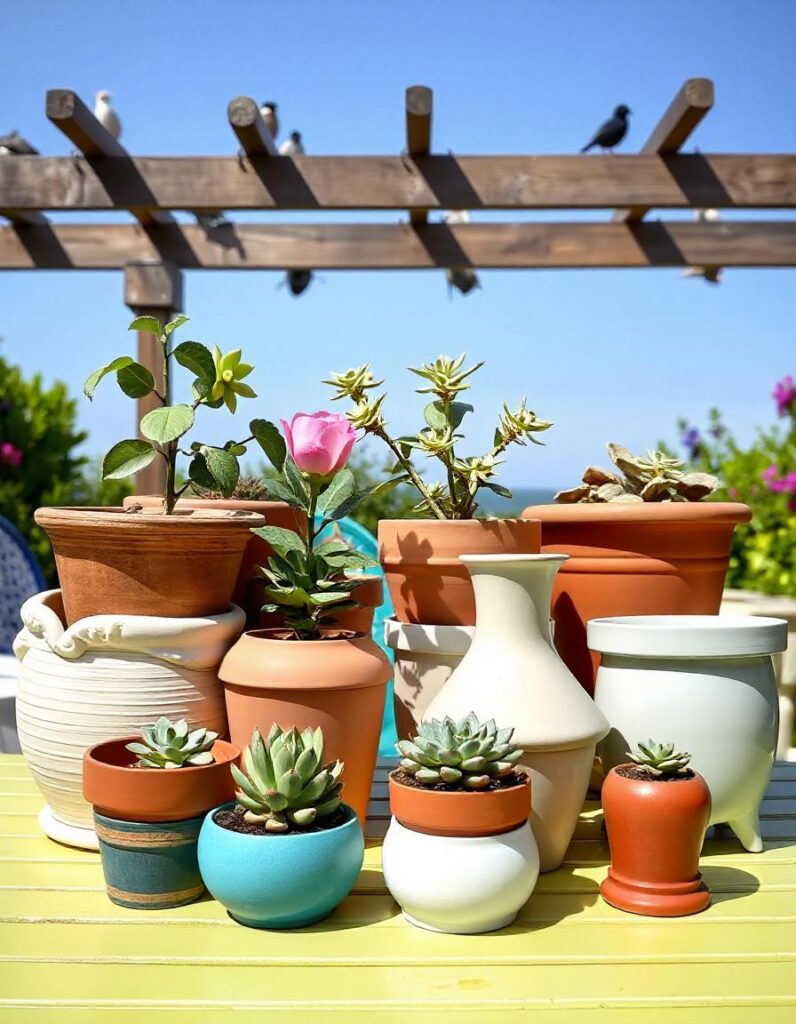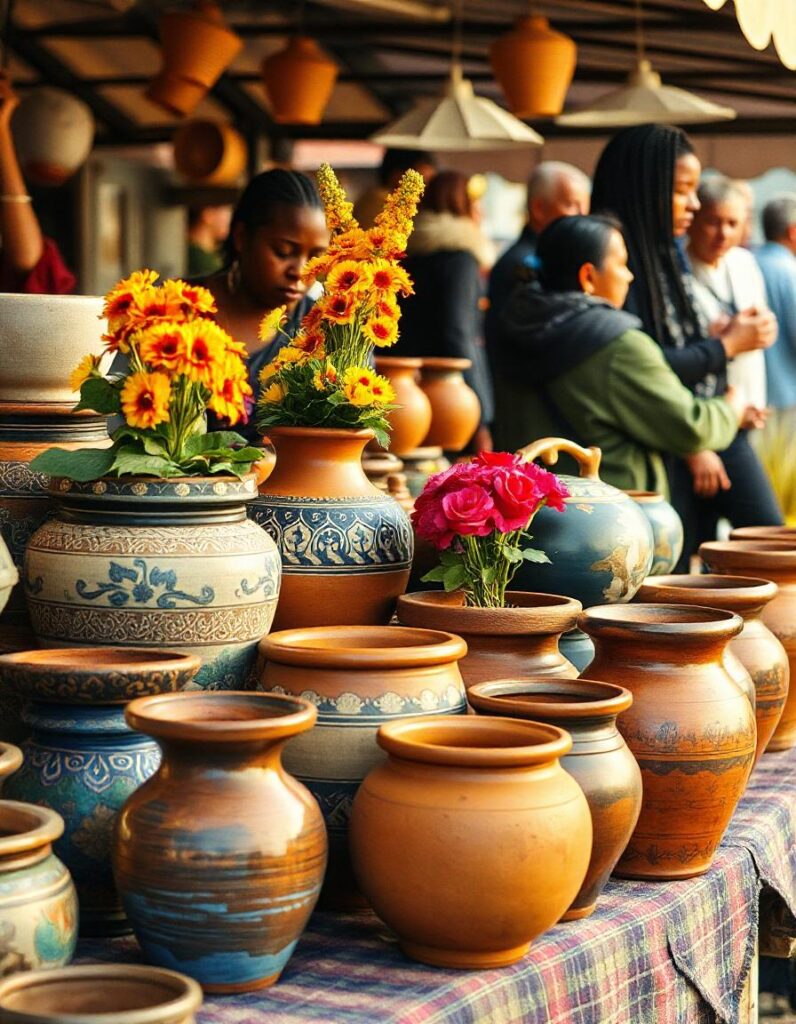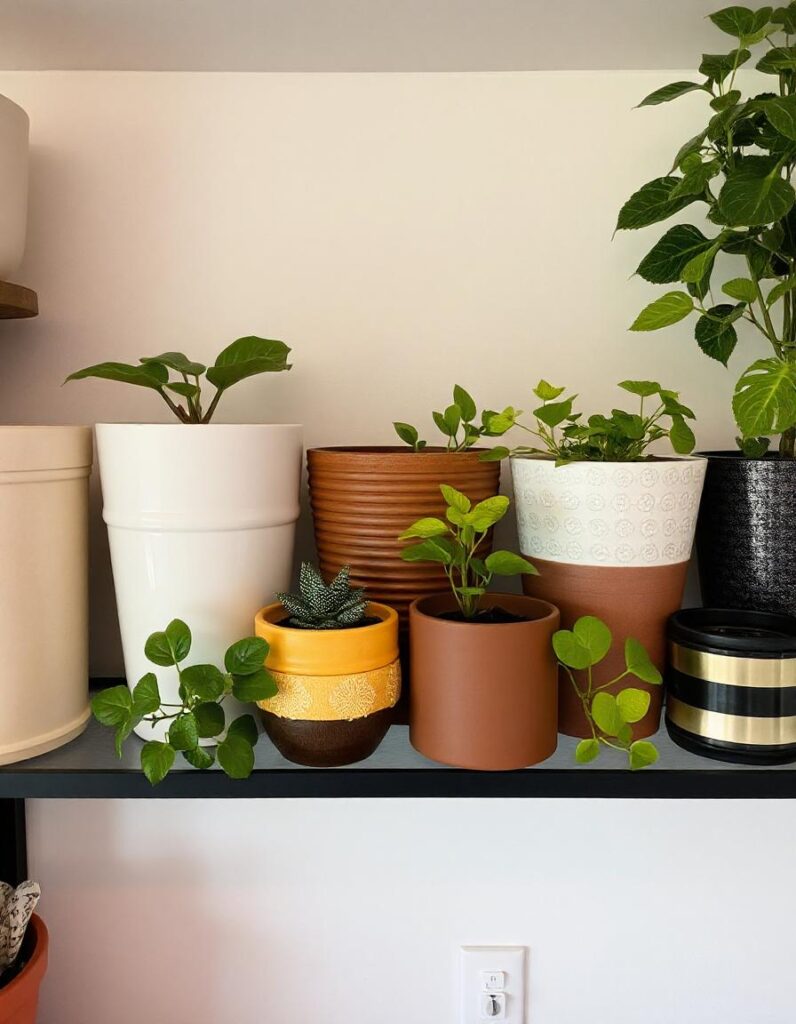What is pot ?
Wellcome to potsandplantseeds ,A pot is a container, typically round and deep, used for various purposes, including cooking, gardening, and decoration. Pots come in a wide range of materials, sizes, and designs, each serving a specific function. They are an essential part of daily life, whether you’re preparing a meal, growing plants, or decorating your home. The versatility of pots makes them a valuable item in both household and commercial settings.

Table of Contents
9 Types of Pots Available in the USA
1. Cooking Pots
Cooking pots are essential kitchen tools used for boiling, simmering, frying, and baking. They are available in various materials, including stainless steel, cast iron, aluminum, and non-stick surfaces. Some common types of cooking pots include:
When it comes to cooking pots, there are various types, materials, and sizes suited for different culinary tasks. Here’s an overview:
Types of Cooking Pots
- Saucepan:
- Use: Ideal for simmering sauces, boiling water, or making soups.
- Size: Usually between 1 to 4 quarts.
- Material: Stainless steel, non-stick, or copper.
- Stockpot:
- Use: Best for making stocks, soups, or boiling large quantities of water for pasta.
- Size: Typically ranges from 6 to 20 quarts.
- Material: Stainless steel, aluminum, or enameled cast iron.
- Dutch Oven:
- Use: Great for slow-cooking, braising, and baking.
- Size: Commonly between 5 to 7 quarts.
- Material: Cast iron, often enameled.
- Sauté Pan:
- Use: For sautéing, searing, and frying.
- Size: Usually around 3 to 5 quarts.
- Material: Stainless steel, non-stick, or aluminum.
- Casserole Pot:
- Use: Suitable for baking and roasting in the oven.
- Size: Varies widely.
- Material: Ceramic, glass, or enameled cast iron.
- Pressure Cooker:
- Use: Used for cooking food quickly under high pressure.
- Size: Generally between 4 to 8 quarts.
- Material: Stainless steel or aluminum.
Materials in pots
- Stainless Steel: Durable, resistant to rust, and often features an aluminum or copper core for better heat distribution.
- Cast Iron: Retains heat well, perfect for slow-cooking and searing. Can be enameled for easier cleaning.
- Non-Stick: Coated with materials like Teflon for easy release of food, though it can wear over time.
- Copper: Excellent heat conductivity, but often requires more maintenance and usually comes with a stainless steel lining.
- Aluminum: Lightweight, affordable, and conducts heat well. Often anodized for durability.
Choosing the Right Pot
Consider the type of cooking you do most often. For example:
- If you frequently make soups or stews, a large stockpot or Dutch oven would be essential.
- For everyday cooking tasks, a versatile saucepan or sauté pan might be the most useful.
Would you like more information on any specific type of pot or advice on what to choose for your needs?
2. Plant Pots
Plant pots, also known as planters, are containers designed to hold soil and plants. They come in various sizes, shapes, and materials, making them suitable for a wide range of plants and indoor or outdoor settings. Here’s a breakdown of the key aspects of plant pots:
1. Materials
- Terracotta: Traditional clay pots that are porous, allowing for good air and water flow. They can dry out quickly, which is ideal for plants that prefer well-drained soil.
- Ceramic: Glazed pots that are non-porous and retain moisture longer, suitable for plants that like consistent moisture.
- Plastic: Lightweight and inexpensive, plastic pots retain moisture well and are available in a wide range of colors and styles.
- Metal: Often used for decorative purposes, metal pots can heat up in direct sunlight and may require lining to prevent rusting.
- Wood: Used for rustic or natural aesthetics, wooden pots often need a liner to prevent rot and soil loss.
- Concrete: Heavy and durable, concrete pots are excellent for outdoor use and large plants but can be difficult to move.
2. Drainage
- Proper drainage is crucial to prevent root rot. Most plant pots have drainage holes at the bottom to allow excess water to escape. Pots without drainage holes can be used as decorative outer containers with a plant in a smaller pot inside, or they can be adapted by adding a layer of gravel or rocks at the bottom.
3. Sizes and Shapes
- Sizes: Pots come in a variety of sizes, from small ones suitable for succulents and small herbs to large ones for trees and shrubs. The size of the pot should match the plant’s root system; too small can restrict growth, while too large can lead to overwatering.
- Shapes: Common shapes include round, square, and rectangular. Some pots are deeper, suitable for plants with long root systems, while shallow pots are ideal for plants with shallow roots like succulents.
4. Self-Watering Pots
- These pots have a built-in reservoir that allows the plant to absorb water as needed. They are particularly useful for people who may forget to water their plants regularly or for plants that prefer consistently moist soil.
5. Decorative Considerations
- Plant pots can also serve as decorative elements in a home or garden. They come in various designs, colors, and finishes to complement different styles, from modern and minimalist to rustic and traditional.
6. Use Cases
- Indoor Plants: Smaller, decorative pots are often used for indoor plants, making them part of home decor.
- Outdoor Plants: Larger, more durable pots are used for outdoor gardening on patios, balconies, or in gardens. Weather resistance is a key factor for outdoor pots.
- Hanging Pots: These are used for plants like ferns or trailing vines and are often made from lightweight materials.
7. Maintenance
- Pots may require regular cleaning to prevent the buildup of salts and minerals from water and fertilizers. Terracotta pots, in particular, can develop a white residue on the outside, which can be cleaned off or left for a more rustic look.
8. Eco-Friendly Options
- Some pots are made from recycled or biodegradable materials, offering a more sustainable option for environmentally-conscious gardeners.
Plant pots are more than just functional containers; they play a significant role in the health and aesthetic appeal of your plants, both indoors and outdoors.
3. Flower Pots
Flower pots, also known as plant pots or containers, are vessels used to grow and display plants. They come in a variety of sizes, shapes, and materials, each with specific features suited for different types of plants and growing conditions. Here’s an overview:
1. Materials
- Clay/Terracotta: These are porous pots that allow for good air circulation and moisture evaporation. They are ideal for plants that prefer dry soil, like cacti and succulents. However, they can crack in freezing temperatures.
- Plastic: Lightweight and durable, plastic pots are affordable and come in a wide range of colors and designs. They retain moisture better than clay, making them suitable for plants that require consistently moist soil.
- Ceramic: Often glazed, ceramic pots can be decorative and are less porous than clay, which helps retain moisture. They can be heavy and are best used for indoor plants.
- Metal: These pots are durable and often used for decorative purposes. However, they can heat up quickly in the sun, which may not be ideal for all plants.
- Wood: Wooden pots or planters offer a natural look and are good for larger outdoor plants. They may require treatment to prevent rotting over time.
- Concrete: Heavy and sturdy, concrete pots are excellent for large plants. They provide good insulation but are not easily moved due to their weight.

2. Designs and Shapes
- Standard Round: The most common shape, good for a wide range of plants.
- Square/Rectangular: These pots are ideal for creating a more structured, modern look and can fit well in corners or along walls.
- Hanging Pots: Designed to be suspended, perfect for trailing plants and saving floor space.
- Window Boxes: Long, narrow pots that fit on window sills or balcony railings, ideal for herbs, flowers, and small vegetables.
- Self-Watering Pots: These come with a reservoir at the bottom, allowing plants to draw up water as needed, reducing the frequency of watering.
3. Drainage
- Drainage Holes: Most flower pots have holes at the bottom to allow excess water to escape, preventing root rot. Some pots come with saucers to catch this water.
- No Drainage: Some decorative pots don’t have drainage holes, which can be risky for plants. In these cases, it’s important to be careful with watering or to use a well-draining soil mix.
4. Uses
- Indoor Gardening: Flower pots allow for the cultivation of plants indoors, providing a controlled environment for houseplants.
- Outdoor Gardening: Pots are used on patios, decks, balconies, and in gardens to grow flowers, herbs, vegetables, and small trees.
- Decoration: Flower pots can enhance the aesthetic appeal of a space, both indoors and outdoors. They are often chosen for their style as much as for their functionality.
5. Care and Maintenance
- Regular cleaning of pots, especially before reusing them for new plants, is essential to prevent the spread of diseases.
- For outdoor pots, especially those made of materials like clay or terracotta, it’s advisable to bring them indoors or protect them during the winter to avoid cracking.
Flower pots are versatile and essential tools in gardening, offering both practical and decorative benefits.
4. Garden Pots
Garden pots are larger and more durable, designed to withstand outdoor conditions. They are ideal for planting shrubs, vegetables, and small trees.
- Raised Garden Pots: Elevated pots that allow for gardening without bending. Example: Keter Urban Bloomer Raised Garden Bed
- Large Outdoor Planters: Spacious pots for bigger plants and small trees. Example: Veradek Metallic Series Cube Planter

5. Clay Pots
Clay pots, including terracotta, are a popular choice for their natural appearance and breathability, which promote healthy root growth.
- Traditional Clay Pots: Basic, unglazed pots often used in gardens. Example: Campania International Clay Planter
- Glazed Clay Pots: Clay pots with a decorative glazed finish. Example: Sunnydaze Glazed Clay Pot
6. Non-stick Pots
Non-stick pots are coated with a material like Teflon to prevent food from sticking during cooking, making them easier to clean.
- Non-Stick Stockpots: Used for cooking soups and stews without food sticking. Example: Circulon Non-Stick Stockpot
- Non-Stick Saucepan: A smaller, versatile pot for sauces and side dishes. Example: Calphalon Non-Stick Saucepan
7. Hanging Pots
Hanging pots are designed for spaces where floor space is limited, such as balconies or small patios. They are often used for plants that trail or cascade over the edges.
- Macrame Hanging Pots: Pots suspended by decorative knotted cords. Example: Mkono Macrame Plant Hanger
- Wall-Mounted Hanging Pots: Pots attached to walls for vertical gardening. Example: Umbra Triflora Hanging Planter
8. Terracotta Pots
Terracotta pots are made from clay and have a distinctive reddish-brown color. They are porous, which allows air and water to move through the pot walls, promoting healthy plant roots.
- Standard Terracotta Pots: Basic pots available in various sizes. Example: Akro-Mils Classic Terracotta Planter
- Decorative Terracotta Pots: Pots with added design elements or glazes. Example: MyGift Rustic Terracotta Pot
9. Decorative Pots
Decorative pots are used primarily for aesthetic purposes, adding beauty and style to your home or garden. These pots can be made from a variety of materials, including ceramic, glass, and metal.
- Ceramic Decorative Pots: Pots with artistic designs, often used indoors. Example: Opps White Ceramic Pot
- Glass Decorative Pots: Clear or colored glass pots, often used for succulents or small plants. Example: Mkono Glass Terrarium Container
- Metal Decorative Pots: Pots with a modern or industrial look, suitable for both indoor and outdoor use. Example: Sunnydaze Galvanized Steel Pot
know more in pots
Pots are a versatile and essential part of everyday life, serving a wide range of purposes from cooking to gardening to home decoration. In the USA, the variety of pots available is vast, catering to every need and preference. Whether you’re looking for a durable cooking pot, a decorative flower pot, or a functional garden pot, there’s a product out there to meet your requirements. By choosing the right type of pot for your specific needs, you can enhance your home, garden, or kitchen, making your space more beautiful and functional.